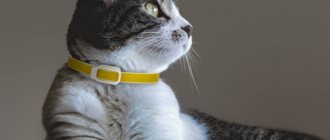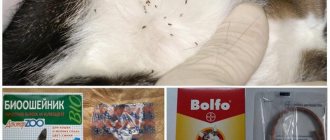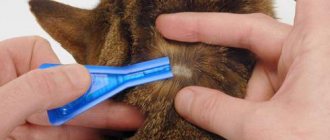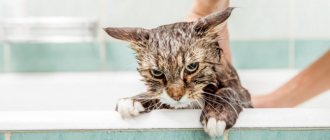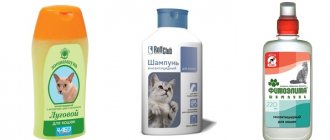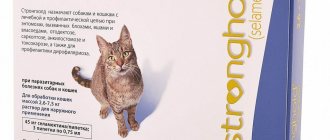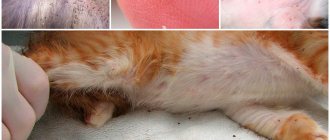Lately, you can often see a cat wearing a flea collar walking down the street. This stylish accessory has a very specific function - protecting the animal from external parasites. However, pet owners do not always have the correct understanding of how a flea collar for cats works. Awareness of this issue will allow you to avoid a lot of mistakes when using this means of protection.
Operating principle
Flea collars for cats
A flea collar for cats is one of the most popular forms of using antiparasitic drugs. The soft rubberized material can be impregnated with repellent or insecticide.
The repellent repels harmful insects, thereby protecting the animal from their attack. As a rule, essential oils have an unpleasant odor for fleas. The instructions for each protective product indicate how long the repellent-based flea collar lasts. As a rule, after 2 - 3 months it needs to be replaced with a new one. Such a device is not a remedy for flea infestation, but only prevents them from attacking the animal.
If the collar is impregnated with an insecticide (organophosphates, carbamate poisons), then the principle of its action is somewhat different. Accumulating in the skin of the animal, the insecticide not only repels blood-sucking insects with its smell, but also kills them if they accidentally bite. Such an accessory can already be used not only to prevent flea and tick attacks, but also as a remedy for the presence of parasites on an animal.
Attention! Cases have been identified where a cat was poisoned by a flea collar. Although they are isolated, they still occur. However, such a result is possible under the following circumstances: the animal’s individual intolerance to specific components of the drug or the combination of a collar soaked in an insecticide with strong drops.
DIY flea collar
Homemade products have a shorter shelf life, but their effectiveness is high. Toxic insecticides cannot be used in the manufacture of the device, because Incorrect dose selection will cause poisoning. It's better to make a biological collar. A strip of fabric should be soaked in essential oils of geranium, eucalyptus, and lavender. You can use a combination of essential oils.
To decorate the fastener of the accessory, you can attach Velcro or sew on buttons. The handmade device is valid for 2-4 weeks. After this it needs to be replaced. Such products can only be used if the pet is not allergic to essential oils. The strong smell of the accessory can cause discomfort to the animal.
Source
Pros and cons
An antiparasitic collar, like any other insecticidal agent, has its positive and negative sides. The undoubted advantages of flea protective agents of this type include the following points:
- Does not require hygiene procedures (washing, combing, etc.), as is the case with the use of shampoos and sprays.
- Universal collars repel not only cat fleas, but also more dangerous parasites - ticks. It is precisely these means of protection that owners often resort to when they take their pets out of town, to the countryside, or into nature.
- Effective protection for a long time. How long to wear a flea collar for cats depends on the type of impregnation. Repellent polypropylene tapes protect your pet for 2 - 3 months. If impregnation with an insecticide was used, the validity period can be up to 6 months.
- The risk of overdose is reduced, since the collar is factory impregnated with a toxic substance in a dose that is non-toxic to the animal.
- A wide selection and affordable prices play an important role in choosing an antiparasitic product.
- A cat walking down the street wearing an accessory is not only protected from attacks by parasites, but also does not look like a stray animal.
“Clandestine” flea collars are used only for prevention.
However, despite the obvious advantages and positive aspects, anti-parasitic straps also have a number of disadvantages:
- Repellent tapes are intended for prevention only. For example, the Celandine flea collar for cats already infested with blood-sucking insects is ineffective. The animal should be treated with shampoo, drops, anti-flea sprays and only then provided with a collar to prevent re-infestation.
- The validity period of an antiparasitic agent in the form of a tape is usually less than that specified by the manufacturer. This is due to the operating conditions of the product.
- The collar is contraindicated for kittens under 2 months.
- The action of the anti-flea accessory is directed only against mature fleas. This form of insecticide does not affect eggs, larvae, and pupae.
- For hyperactive animals, it is better not to use a collar, but to resort to other means of protection (for example, drops), since when actively climbing trees, the cat can get caught and get injured.
- Whether a flea collar helps cats can only be judged after at least 5 days have passed from the date of use. You should not expect instant death of insects.
When choosing an anti-parasitic collar as protection against cat fleas and ticks, you should weigh the pros and cons. In this case, it is necessary to take into account the physiological state of the pet, its lifestyle, and level of health. You should also consider the potential risk of infestation not only from cat fleas, but also from more dangerous parasites.
Advantages and disadvantages of the product
Flea collars for cats work on the principle used to create shampoos, drops and sprays against blood-sucking insects. The flexible polyvinyl chloride base contains microcapsules containing insecticides and repellents that kill adult insects that parasitize the animal’s body and repel strangers.
Flea collars
The insecticides that are included in a cat flea collar are organophosphates (tetrachlorvinphos, diazinon), peritroids (cyphenothrin, deltamethrin, imidacloprid and flumethrin), amitraz, fipronil and carbamate pesticides. But they have the same principle of action - when an insect comes into contact with an insecticide, the transmission of a nerve impulse through the presynaptic cleft of neurons is blocked. The muscle fibers innervated by them contract spastically and cease to function. The paralyzed insect dies.
The insecticides used are substances of contact-intestinal action. The drugs have a low (3-4) toxicity class and, if safety rules are followed, cannot lead to serious poisoning of the cat.
Some developers add S-methoprene to the capsules, which damages the juvenile hormone involved in the formation of chitin. As a result, the insect at the larval and egg stages develops abnormally and dies.
Repellents are natural substances made from essential oils and plant extracts that repel cat fleas with their scent. The active substances “stick” to the surface of the fur, spread in the lipid layer of the skin when the animal moves, penetrate the hair follicle and the cavity of the sebaceous glands, providing a prolonged insecticidal-acaricidal effect.
A flea collar for a cat has its advantages:
- easy to use;
- can be used if the animal is afraid of water;
- special models are used to protect kittens and pregnant cats;
- the insecticide has a detrimental effect on ticks, allowing the animal to shake off the parasite;
- the presence of a collar guarantees the cat’s safety when catching stray animals;
- When worn constantly, the animal is protected from blood-sucking insects for a period of 2 to 7 months.
Whether a flea collar helps cats can only be determined after careful observation over several days. There are other disadvantages to this remedy:
- service life may be shortened due to constant wetness;
- a hyperactive animal risks injury by getting caught in the collar;
- Whether a flea collar is effective depends on microclimatic conditions, the individual characteristics of the animal’s body, and the level of immunity;
- When buying counterfeit products, your cat may become intoxicated with insecticides.
Will a flea collar help if I already have fleas? Judging by the assurances of manufacturers and customer reviews, if the animal wears it constantly, it will be possible to get rid of the imago within a period of 2-3 days, and then you will simply have to wait until the larvae hatch from the eggs.
The pet owner can decide for himself whether the collar is harmful to his pet. When selected correctly and following the instructions for use, the product is safe and effective. And harm can be caused by a low-quality product or if it is worn during an animal’s illness, when the pet is weakened. In other cases, the protective accessory will not affect the health of the pussy.
For reference: a flea collar for dogs is usually a plastic product in the form of a flexible tape with a buckle, which sometimes has a characteristic odor due to the presence of highly toxic chemicals in the composition.
How does a flea collar work? After some time from the moment the product is put on, the dog becomes protected from fleas and ticks: insecticidal and repellent components are released from the collar and distributed over the pet’s fur and skin surface. The substances maintain the required concentration the entire time the collar is worn on the dog.
How long should you wear a flea collar? It is recommended to wear it constantly, without taking it off even at night - only in this case will a reliable result be achieved.
Collars are:
- Chemicals containing substances harmful to parasites. Used for adult dogs.
- Biological, the action of which is based on the medicinal properties of medicinal herbs and essential oils. Can be used for puppies, sick individuals and pregnant dogs.
- Ultrasonic – universal, odorless and free of any chemicals, but more expensive. However, it must be kept in mind that many consider this type of collar to be the least effective option.
A wide range of dog collars often confuses owners: what to choose? There are several criteria that can help with this.
Possible negative consequences
As one of the forms of using an insecticide against fleas, an anti-flea accessory can cause the following troubles:
- Allergy to flea collar . This phenomenon is not uncommon when using an antiparasitic accessory. Allergies most often occur when permethrin and tetrachlorvinphos are used as impregnations. The reaction may manifest itself in the form of itchy skin, sneezing, and watery eyes. In acute cases, convulsions, loss of coordination of movement, depression, and loss of consciousness are possible. Allergy symptoms usually appear 1 to 2 hours after use.
- Poisoning . Symptoms of poisoning by insecticides contained in the collar are similar to those of an allergic reaction. But in case of intoxication, the first signs appear 5 - 6 hours after using an accessory soaked in chemicals, and in case of allergies - in the first hour.
It is impossible to answer unequivocally the question of whether a flea collar is harmful. Allergic manifestations, poisoning and chronic intoxication certainly have a negative impact on the pet’s health. It is also recommended to periodically check the condition of the pet’s skin during the entire period of use of the protective device.
Safety rules for putting on and wearing
Many pet owners mistakenly believe that there are no special rules on how to put a collar on a cat to protect it from fleas. However, for effectiveness and safety, you should listen to the recommendations of manufacturers and veterinary specialists:
- Use only products intended for this type of animal (do not use products intended for dogs on cats).
- Do not cut the product into pieces; it is intended for one animal, taking into account its weight.
- The collar should be secured to the pet so that it does not dangle around the neck, but does not squeeze too much. It should be remembered that in different poses the diameter of the pet’s neck is different. Manufacturers recommend making a gap of one centimeter between the strap and the body.
- If the protective device is periodically removed, it should be stored in a closed plastic bag. This will prevent a decrease in the preventive effect ahead of time.
- Before putting on a flea collar for cats, the instructions should be carefully studied for combination with other insecticides. As a rule, it is strictly forbidden to use a collar in combination with other flea control products. This can lead to an overdose and poisoning of your pet with insecticides. If the animal has been treated with shampoo, injections, tablets, sprays, the collar can only be put on 3 - 5 days after the parasites have been destroyed.
We recommend reading the article about where domestic cats get fleas. From it you will learn about possible routes of infection, signs and symptoms of a pet having fleas, and the dangers that fleas pose to humans and cats.
Criterias of choice
Flea collars
On the shelves of pet stores there is a wide selection of protective accessories for four-legged friends. Therefore, the pet owner, confused among the variety of models, asks the question: “how to choose the best?” The collar must match the volume of the animal's neck. They produce products with a length of 35-40 cm. The tape has a lock with which it can be secured by adjusting the volume.
We invite you to read: Why earth fleas are dangerous for humans
Many collars have a specific smell, but there are products that are odorless. Which flea collar is best for cats can only be decided by trying several types. The packaging contains detailed instructions, composition, how the product acts on parasites, and features of use. The collars are made of moisture-resistant material and the insecticide is not washed off with ordinary water. Even if the coating has been damaged, it will be restored within a week.
A flea collar for cats, the instructions for which recommend handling and safety rules, is a therapeutic and preventive remedy. But to enhance effectiveness, it is better to put it on your pet after bathing with a special insecticidal shampoo or other external treatment against blood-sucking insects.
Flea collars
Owners of furry pets should ask the seller or consultant how long it takes for the protective accessory to take effect. Some types of insecticides have a delayed but prolonged effect. If you put such a collar on a cat, it starts working only after 3-8 hours. During this time, infection may occur. This is especially dangerous when infected with ixodid ticks. Having dug into the cat’s skin, they will not leave it even after activating the product.
How to put a flea collar on a cat is described in the instructions.
Selecting the best options among those offered
A wide selection of antiparasitic devices on the pet products market is presented by both foreign and domestic manufacturers:
- "Bars" . A domestically produced protective agent based on fipronil provides a preventive effect for 4 months. Can be used from 2 months of age. Contraindications: pregnancy, feeding. It is not recommended for use in sick and weakened animals.
- "Befar" . A flea and tick collar for cats from a European company provides maximum protection 5 days after use and remains effective for 5 months. Not recommended for pregnant, lactating cats and young animals under 6 months of age.
- "Bolfo " The active ingredient of the product is propoxur, which has a universal insecticidal effect. The collar can be used on productive cats after consultation with a veterinarian.
- “Clandestine” . Collar for cats and dogs of domestic production. The active ingredient is permethrin, which destroys fleas, lice-eaters, and ixodid ticks. The protective device is not recommended for pregnant or lactating females. Can be used for kittens from 4 months of age.
- “Dana-ultra” . A combined action product that is effective against fleas and ticks. Used from 2 months of age, not recommended for productive animals.
How to choose a collar
The effectiveness of a cat collar in fighting fleas largely depends on the quality of the product. When choosing a product, be guided by the following principles:
- purchase a collar only in specialized pet stores,
- the product must be in a sealed bag located inside the box,
- there must be instructions in the box or packaging,
- give preference to well-known brands with a positive reputation,
- the product must be certified in the territory of the Russian Federation,
- check if the expiration date is expired,
- the collar must correspond to the weight or age of the animal,
- for kittens, pregnant and lactating animals, choose products that suit these categories,
- do not buy collars for cats intended for large dogs (the concentration of the insecticide may be too high for Barsik).
Video: rules for choosing a flea collar - advice from a veterinarian
Can the collar be used on a pregnant cat?
The Bolfo flea collar can be used on pregnant cats
Despite the widespread advertising and popularity of the protective accessory, veterinarians are often asked questions about its effect on the animal’s health, side effects, and use in a particular physiological condition. And some of the most popular ones are about wearing while expecting offspring.
- Is it possible to put a flea collar on a nursing cat? The use of this type of protection for a nursing female is not recommended by both manufacturers and veterinary specialists. The insecticide used to impregnate the tape has a long-lasting effect, which can cause severe poisoning in small kittens and lead to the death of offspring. To treat a nursing cat against blood-sucking insects, there are specially developed preparations, for example, “Frontline” drops.
- Is there a flea collar available for sale for a pregnant cat? Almost all insecticide-impregnated tapes are not recommended for pregnant cats. Veterinary specialists prefer collars based on essential oils to protect an animal in an interesting position. They are less dangerous in terms of intoxication, but will not protect against allergic manifestations.
- Insecticidal tape “Bolfo” can be used for pregnant pets, but only after prior consultation with a veterinarian who will assess the health of the expectant mother.
The question of which flea collar is best is difficult to answer even for a veterinarian with extensive experience. In any case, you need to choose products from well-known companies that are responsible for their pet products, buy protective equipment from trusted veterinary pharmacies, and do not skimp on cheap Chinese counterfeits.
Similar articles
- How fleas reproduce in cats: how many of them live on...
From it you will learn about the signs of a parasite in a pet, effective means for getting rid of fleas, such as shampoos, drops on the withers, flea collars, sprays. … For cats. Flea dermatitis in a cat. Read more - How to remove fleas from a cat, how to get rid of them (wash, anoint...)
We recommend reading the article about how a flea collar works. From it you will learn about the principles of operation of flea collars for cats, types of devices, and the possible negative consequences of their use... Read more
- How to wash a cat if he is afraid, how to do it...
The most popular are regular liquid shampoos for washing domestic cats. ... Since there are going to be water procedures, it’s a good idea to figure out how to wash your cat for fleas in order to combine both pleasant and useful things. Read more
- Where does a domestic cat get fleas: what they look like, what...
How does a flea collar for cats work and is it real... How to treat ear mites in a cat: what is it, where does it come from... Why does a cat's hair fall out, it comes out in clumps... Read more
- A cat has tubercles on its ears: how to treat it, what to do if...
There are quite a lot of parasites that terrorize pets. If a cat has bumps on its ears, how to treat the beauty? ... We recommend reading the article about how a flea collar works. Read more
